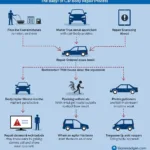When renewing a car diagnostic process, several key elements are crucial for accurate and efficient troubleshooting. Understanding what’s needed goes beyond simply plugging in a scanner; it requires a combination of the right tools, updated software, and a good understanding of the vehicle’s systems. Let’s delve into the essential components required for a successful car diagnostic renewal.
Essential Tools and Software for Car Diagnostic Renewal
Renewing your approach to car diagnostics often starts with evaluating your existing tools and software. Are they up to date? Do they offer the capabilities needed for today’s increasingly complex vehicles? Here’s a breakdown:
Diagnostic Scanner/Code Reader: The Core Tool
A high-quality diagnostic scanner or code reader is the backbone of any car diagnostic process. These tools allow you to communicate with the vehicle’s onboard computer, retrieve diagnostic trouble codes (DTCs), and access live data streams. When renewing your car diagnostic process, consider investing in a scanner with advanced features such as bidirectional control, which lets you test components, and access to manufacturer-specific codes. Don’t settle for outdated models; newer scanners offer improved processing power, faster communication speeds, and broader vehicle coverage.
Software Updates: Keeping Pace with Technology
Just like your smartphone, car diagnostic software needs regular updates. Manufacturers constantly release new software versions that include updated code definitions, enhanced functionality, and expanded vehicle coverage. When someone renews a car diagnostic process, ensuring the latest software version is installed is paramount. Out-of-date software can lead to misdiagnosis, missed codes, and ultimately, wasted time and money.
Reliable Internet Connection: Crucial for Updates and Research
A stable internet connection is essential for downloading software updates, accessing online repair databases, and researching technical service bulletins (TSBs). When renewing a car diagnostic, a reliable internet connection becomes even more crucial, allowing you to quickly access the latest information and stay informed about emerging issues and solutions.
Technical Service Bulletins (TSBs): Manufacturer Insights
TSBs are documents released by vehicle manufacturers to address known issues and provide repair instructions. Accessing TSBs relevant to the vehicle being diagnosed can significantly speed up the troubleshooting process. These documents often contain valuable insights that might not be readily available elsewhere, making them a vital resource when someone renews a car diagnostic approach.
Understanding Vehicle Systems and Diagnostic Procedures
Beyond the hardware and software, a solid understanding of vehicle systems and diagnostic procedures is fundamental to effective car diagnostics.
Electrical System Knowledge: The Foundation
A strong grasp of automotive electrical systems is crucial. Modern vehicles are increasingly reliant on complex electronic control units (ECUs) that manage various systems. Understanding how these systems interact is vital for accurate diagnosis. When renewing a car diagnostic, brushing up on electrical fundamentals can be highly beneficial.
Diagnostic Strategies: A Systematic Approach
A structured diagnostic approach is critical for efficient troubleshooting. This involves systematically checking various components and systems, following logical steps to isolate the root cause of the problem. When renewing a car diagnostic process, adopting a more organized and methodical strategy can significantly improve accuracy and reduce diagnostic time.
Continuing Education: Staying Ahead of the Curve
The automotive industry is constantly evolving. New technologies emerge regularly, requiring technicians to stay updated. When someone renews a car diagnostic approach, committing to ongoing learning and training is essential for maintaining competence and staying ahead of the curve.
What Questions Should I Ask When Renewing a Car Diagnostic?
Renewing your car diagnostic approach means being proactive. Here are some crucial questions to consider:
- What are the most common issues I encounter?
- Are my current tools and software sufficient?
- How can I improve my diagnostic efficiency?
- What training or resources can I leverage?
Conclusion: Staying Current with Car Diagnostics
Renewing a car diagnostic process involves more than just updating your tools and software. It requires a commitment to continuous learning, a dedication to adopting best practices, and a willingness to embrace new technologies. By focusing on these key elements, you can ensure your car diagnostic approach is effective, efficient, and capable of handling the complexities of modern vehicles.
FAQ
-
How often should I update my car diagnostic software? It’s recommended to check for updates at least quarterly, if not more frequently, as manufacturers release updates regularly.
-
What type of scanner is best for a DIYer? A good quality OBD-II code reader is sufficient for basic diagnostics and retrieving trouble codes.
-
Where can I find reliable TSBs? You can often find TSBs on manufacturer websites or through reputable online repair databases.
Common Scenarios:
Scenario 1: Intermittent Fault – The check engine light illuminates sporadically. This requires careful monitoring of live data and potentially using a data logger to capture the fault when it occurs.
Scenario 2: Multiple DTCs – The scanner retrieves numerous trouble codes. A systematic approach is crucial here, starting with diagnosing the most critical codes first and then addressing any related codes that may be triggered by the primary fault.
Further Reading:
- Understanding OBD-II Codes
- Advanced Diagnostic Strategies
- Choosing the Right Diagnostic Scanner
Need help? Contact us via WhatsApp: +1(641)206-8880, Email: [email protected]. Our customer service team is available 24/7.


